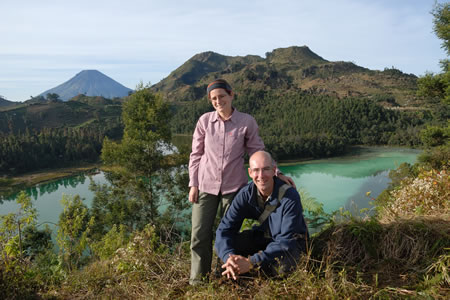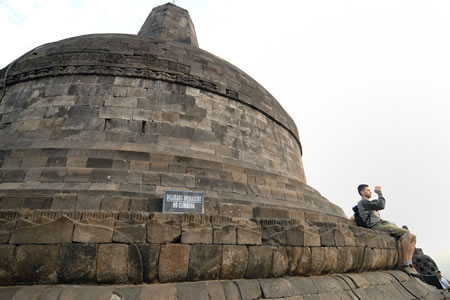English | Dutch |
|
| The luxury of Java | |
Kalianda (Indonesia) to Yogyakarta (Indonesia), Jul-12-08 / Jul-31-08 |
|
We are at the moment already for two weeks on Java. Time flies, and the end of this week, we will fly to Penang in Malaysia. We have to leave Indonesia before August 4th, because at that day our 60-days visa expires. We hope to arrange a new 60-days visa for Indonesia in Malaysia en for now; we assume that it is possible. The visa regulations of Indonesia are incomprehensible for us. The easiest way to obtain a visa is to buy it at one of the international air or sea borders of Indonesia. In that case you will get a 30-day visa on the spot. For most tourists it is enough, but if you want to see a more than just Java and Bali, you definitely need more days. A 60-day visa is also possible, but for this visa you have to apply for it at one of the Indonesian embassies worldwide. An even than you have to look carefully, because not all embassies are willing to issue 60-day visas. The worst part of the Indonesian visa regulations is that the tourist visas are not extendable. So, if you want to stay longer than your visa allows you to do, you fist have to leave the country and get a new visa on the airport/seaport at arrival, or by applying for a new visa at one of the embassies. And for that reason we have to fly to Malaysia for a week. The tourist industry in Indonesia is complaining a lot about these more strict regulations. The result of the regulations is that the majority of the tourists only visit Java and Bali, and almost none of them go to other parts like Sumatra, Sulawesi or Nusa Tengarra. It is a time consuming and costly activity to leave the country for a ‘new’ visa, especially when you are travelling in the more (eastern) remote areas of the country. So, people that earn their living in the tourist business outside Bali and Java have bad luck. But that is not a main concern for the Indonesian politicians, because most of them live on Java. |
|
 |
|
Edwin and Ivonne on the Dieng Plateau |
|
| We left Sumatra two weeks ago with mixed feelings. The island is absolutely a great destination, but travelling over there is not easy. The distances are huge, the travelling days long and the food not very varied. Eventually we are glad that we crossed the whole island by bus, but if we had to do it again, we probably would take a flight for one of the stretches. Especially the southern part of the island is not as beautiful as the northern part. We travelled in Sumatra approximately 2000 kilometres, in a little bit more than 90 bus hours. That means an average speed of just over 20 km/hour! Now that we are on Java for two weeks, we are going to appreciate Sumatra more and more. The western and central part of Java that we visited so far, are not as nice as Sumatra, it is much more crowded and the people are a little bit less friendly. This is probably the result of the huge number of tourists that travel the stretch from Jakarta to Bali. We saw last weeks an amazing number of Dutch people. In some of the touristy places, more than half of the entire tourist legion seems to be Dutch. And that is something you will notice because the Dutch people, or people from Holland (just a part of The Netherlands) as they like to call themselves, like to let you know that they arrived. But we do not want to generalize our fellow countrymen, because we sometimes also meet very nice and pleasant Dutchmen.
We are still a little bit surprised when so many people go to Java for their holiday and not to one of the other parts of Indonesia. The island is nice, but not spectacular. Especially the western and central part of the island, that we visited so far, does not have a lot to offer. And that is also what many other visitors think, because most of the other travellers that we meet can’t wait till they reached Bali. Most nature on Java is destroyed and replaced by picturesque rice fields and other agricultural grounds. You can’t see a lot of it from the bus, because Java is characterized by ‘ribbon building’. That means that most towns and villages are concentrated along the main roads, because that is the place to establish your business. And there are many little shops in Java, all lined up along the main roads on Java, making the environment very ugly. The cities on Java are even worse. Also a city like Yogyakarta, seen as one of the tourist highlights on the island, is a disappointment in our opinion. The sights are moderate, the city is washed over by stinking and smoking vehicles and on every street corner you will be approached by n irritating Batik sales man. Batik is a fabric that is traditionally made and painted in Java. There are many designs, but they all have one thing in common: they are ugly and oldish. You probably know them; it is the glossy and often yellowish fabric that is used to make blouses for the older Grandpa’s among us. The Borobodur is another example. It is undoubtedly a beautiful place, but it is so washed over by foreigners and local picnickers that it is difficult to really enjoy it. Most people go there just because it is famous, and almost nobody has respect for this ‘former’ religious relic. People are walking around in shorts, flip-flops and tan tops, and climb the monument on places where it is not allowed, just to make pictures. It is also a pity that the temple is not used anymore in daily religious activities, which means that the atmosphere is completely gone. | |
 |
|
A tourist on the Borobodur despite the signs of "no climbing" |
|
But Java also has its advantages. One of the great things about Java is that the facilities are good. De roads are in good condition, the travel distances are short, the hotels are ok, the food is good and the train system is perfect. Java also still has some great places to visit that are only visited by a fraction of the tourists. One example is the spectacular Krakatau volcano. This volcano of the volcanoes is absolutely worth a visit and can be done as a day trip from Java, even though it is officially part of Sumatra (see also the photo impression about Krakatau). Another example that is often missed by travellers is the Dieng Plateau. This plateau, located on an altitude of more than 2000 metres is one of the few places left on Java where you can still observe the traditional Javan life. It is a super picturesque area, characterized by volcanoes, steaming craters, old Hindu temples, volcanic lakes and friendly people. The people earn their money with agricultural activities on their picturesque terrace fields, especially the growing of potatoes. When they see you strolling through the area, they will stop working for some minutes, to treat you on a big smile and some passionate waving. And school kids will run to the fence of their school to practice the one or two sentences English that they know. It is also possible to see the geothermal installations that are used to transform water to steam by using the volcanic heat of the earth. If you really want to see the traditional Javan life as it used to be, you should really consider a visit to this great plateau. But ok, the first part of Java is almost ending for us. In a couple of days we will travel back to Jakarta for our flight to Malaysia. There we will have a week to arrange our second 60-day visa for Indonesia. On August 9th we will fly back to Jakarta to finish our visit to Java and Bali and to spend approximately 6 weeks in Sulawesi. After Sulawesi it is time to travel to Bangkok for our short ‘holiday’ back to Europe. We really like to see our family again and can’t wait to do some shopping in a well stocked supermarket. But so not misunderstand us, in November we fly back to Asia again to continue with our journey.
|
|
| <Previous weblog> | |